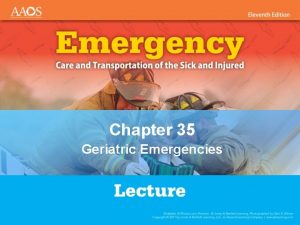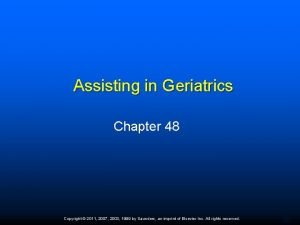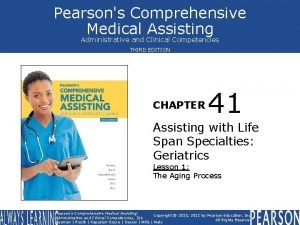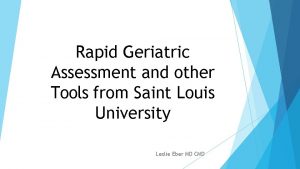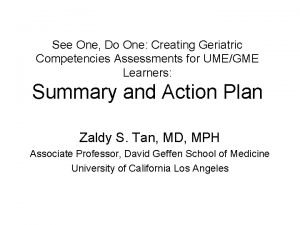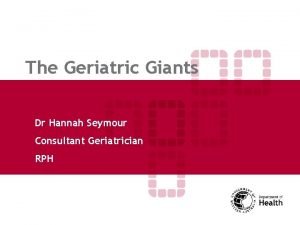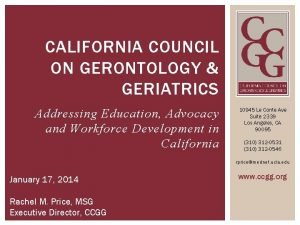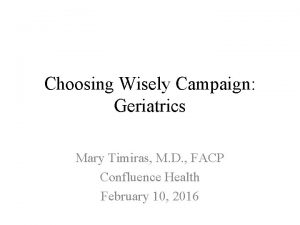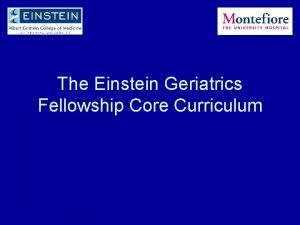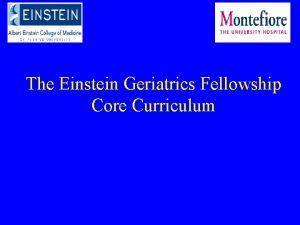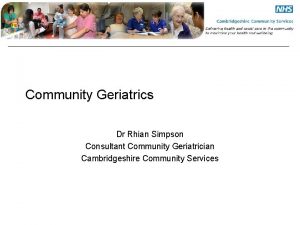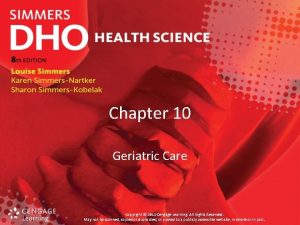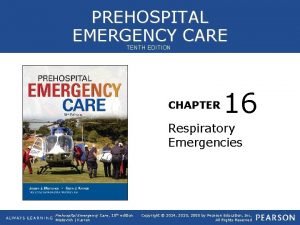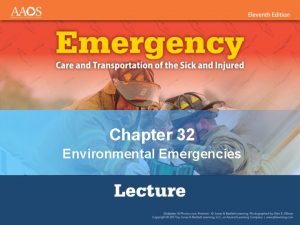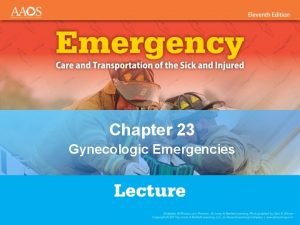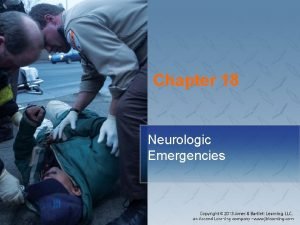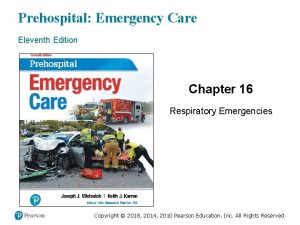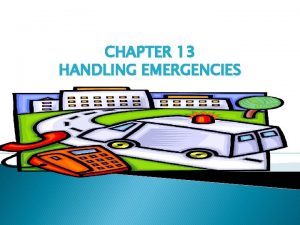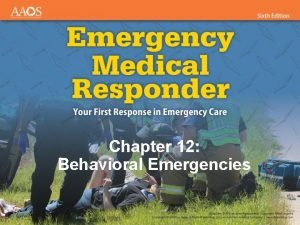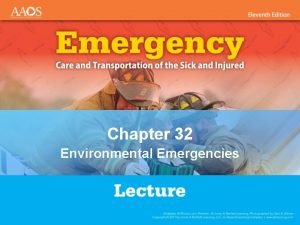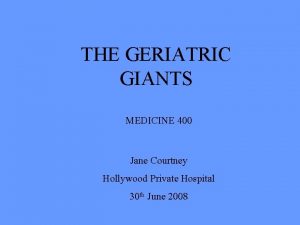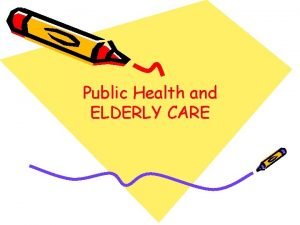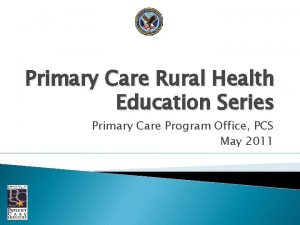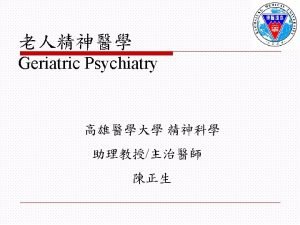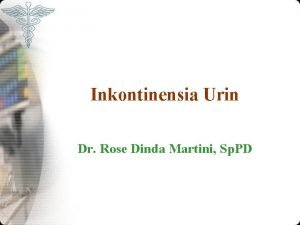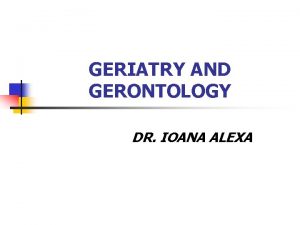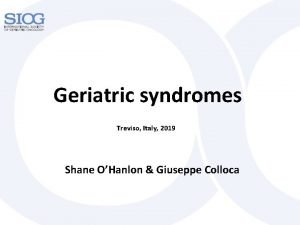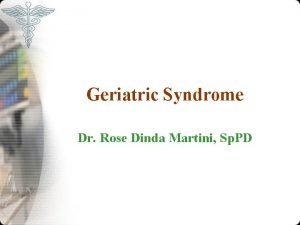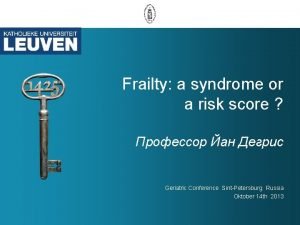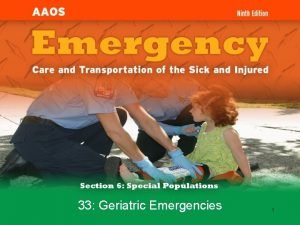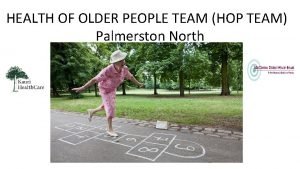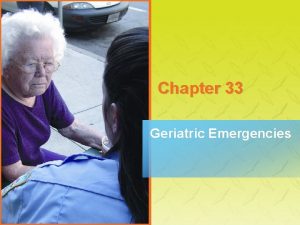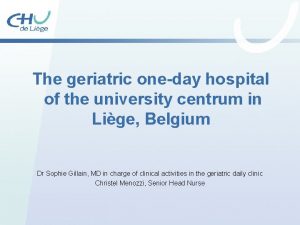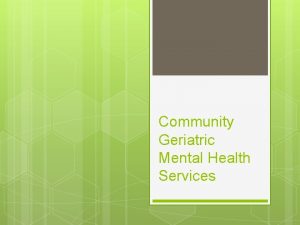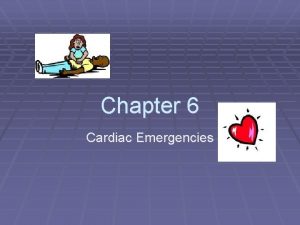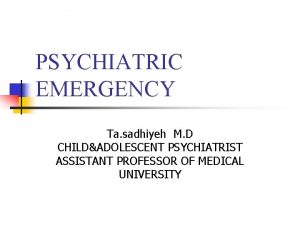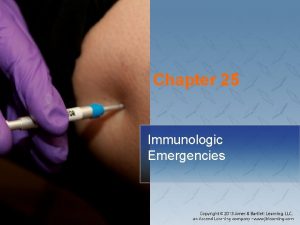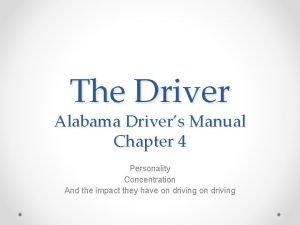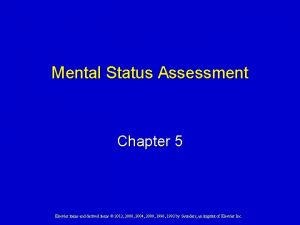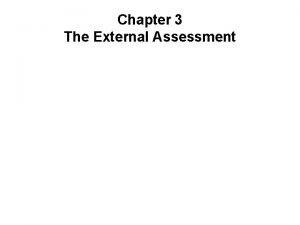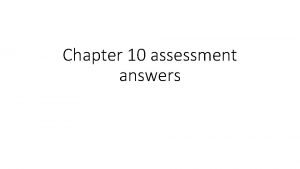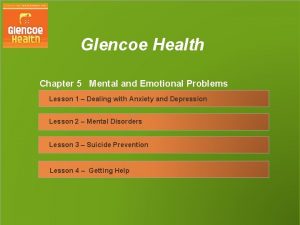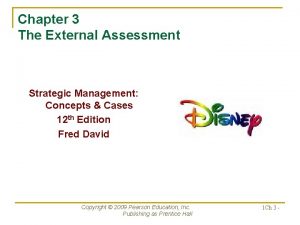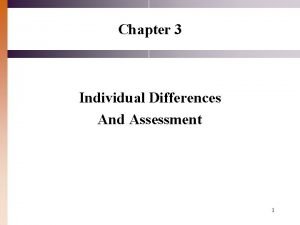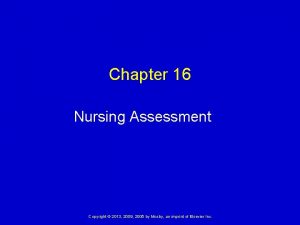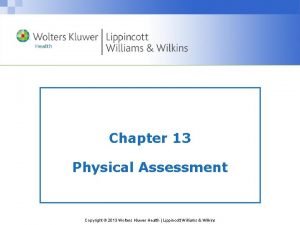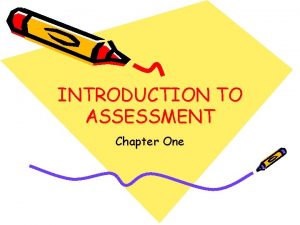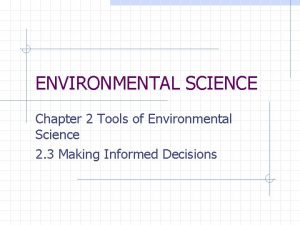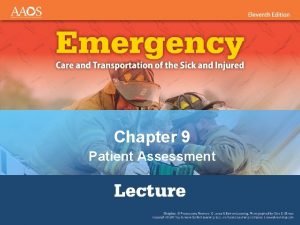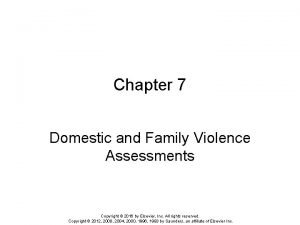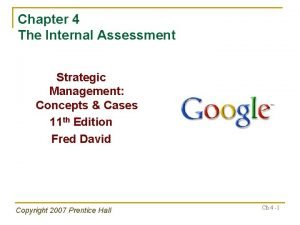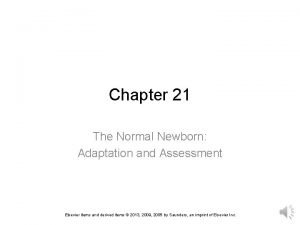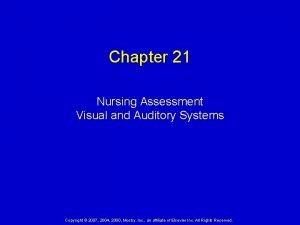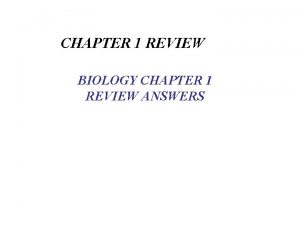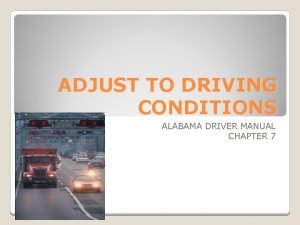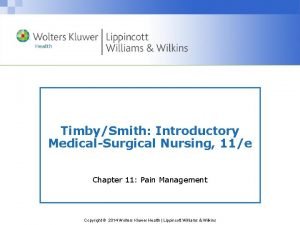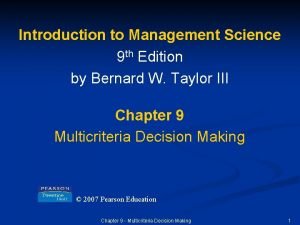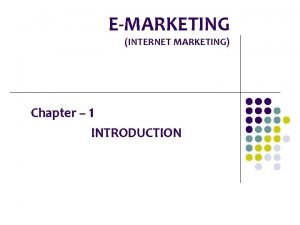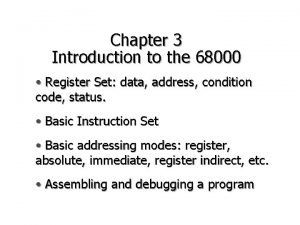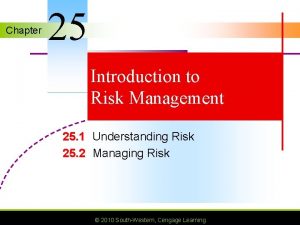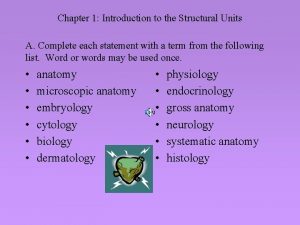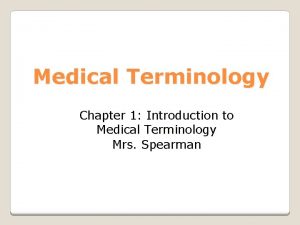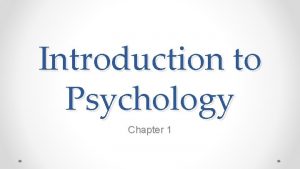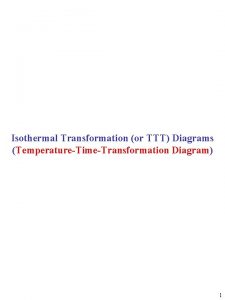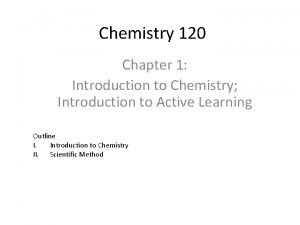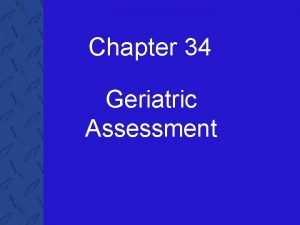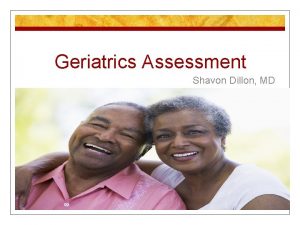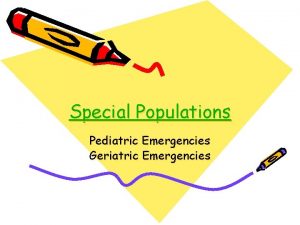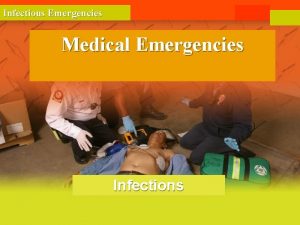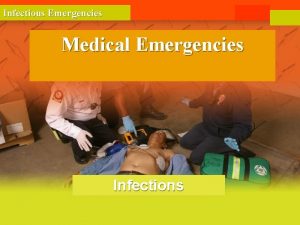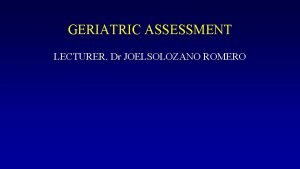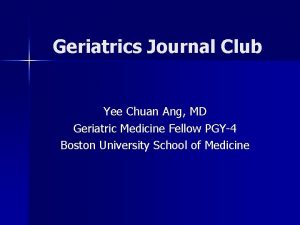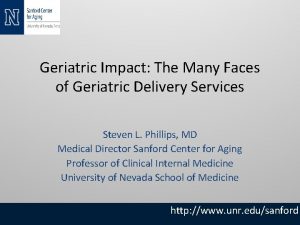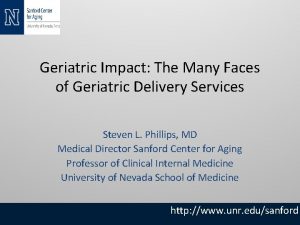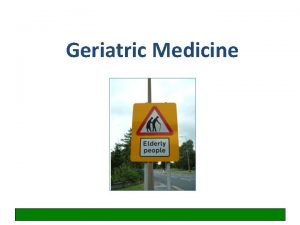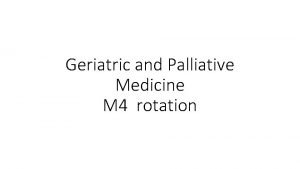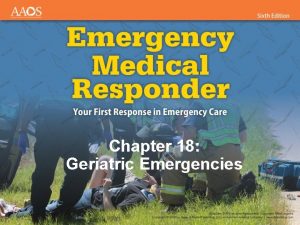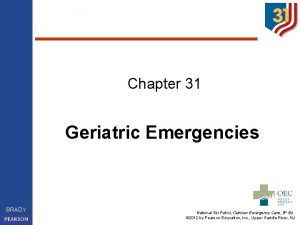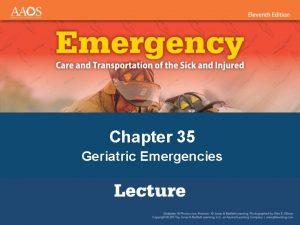Chapter 35 Geriatric Emergencies Introduction Geriatrics is assessment












































































































































- Slides: 140

Chapter 35 Geriatric Emergencies

Introduction • Geriatrics is assessment and treatment of disease in a person 65 years or older. • Geriatric patients present as a special challenge for health care providers. • Injuries and illness are affected by chronic conditions, multiple medications, and the physiology of aging.

Generational Considerations • It is important to understand appreciate how the life of an older person might differ from yours. • It takes time and patience to interact with an older person. – Treat the patient with respect. • Make every attempt to avoid ageism.

Communication and Older Adults (1 of 2) • Communication techniques – Speak respectfully. – Identify yourself. – Be aware of how you present yourself. – Look directly at the patient at eye level. – Speak slowly and distinctly.

Communication and Older Adults (2 of 2) • Communication techniques (cont’d) – Have one person talk to the patient and ask only one question at a time. – Do not assume that all older patients are hard of hearing. – Give the patient time to respond. – Listen to the answer. – Explain what you will do before you do it.

Common Complaints and the Leading Causes of Death in Older People (1 of 2) • Geriatric patients are predisposed to problems not seen during youth. – Hip fractures are common. – More likely to occur when bones are weakened by osteoporosis or infection – Sedentary behavior can lead to pneumonia and blood clots.

Common Complaints and the Leading Causes of Death in Older People (2 of 2) © Jones and Bartlett Learning

Changes in the Body • The aging process is accompanied by changes in physiologic function. • All tissues in the body undergo aging. – Decrease in the functional capacity of various organ systems is normal but can affect the way a patient responds to illness.

Changes in the Respiratory System (1 of 3) • Age-related changes can predispose an older adult to respiratory illness. – Airway musculature becomes weakened. – Alveoli in the lung tissue become enlarged and the elasticity decreases. – The body’s chemoreceptors slow with age.

Changes in the Respiratory System (2 of 3) • Pneumonia – Inflammation/infection of the lung from bacterial, viral, or fungal causes – Leading cause of death from infection in Americans older than 65 years – Immune suppression associated with aging increases the risk of contracting pneumonia.

Changes in the Respiratory System (3 of 3) • Pulmonary embolism – Condition that causes a sudden blockage of an artery by a venous clot – Patients will present with shortness of breath and sometimes chest pain. – Signs and symptoms – Treatment

Changes in the Cardiovascular System (1 of 4) • The heart hypertrophies with age. • Cardiac output declines. • Arteriosclerosis contributes to systolic hypertension.

Changes in the Cardiovascular System (2 of 4) • Geriatric patients are at risk for atherosclerosis – Accumulation of fat and cholesterol in the arteries © Jones and Bartlett Learning

Changes in the Cardiovascular System (3 of 4) • Increased risk formation of an aneurysm – Severe blood loss can occur. • Blood vessels and heart valves become stiff and degenerate. – Changes in the electrical conduction system of the heart lead to abnormal heart rates/rhythms

Changes in the Cardiovascular System (4 of 4) • Venous stasis – Loss of proper function of the veins in the legs – Can lead to deep vein thrombosis or pulmonary embolism

Heart Attack • The classic symptoms of a heart attack are often not present in geriatric patients. • Signs and symptoms of cardiovascular disease

Heart Failure (1 of 2) • The signs and symptoms will differ with right - or left-sided failure. • Right-sided heart failure occurs when the fluid backs up into the body. – Signs and symptoms

Heart Failure (2 of 2) • With left-sided heart failure, fluid backs up into the lungs. – Causes pulmonary edema and shortness of breath • Paroxysmal nocturnal dyspnea – Sudden attack of respiratory distress – Patient is awakened from sleep

Stroke (1 of 3) • Leading cause of death in older people • Preventable risk factors: smoking, diabetes, hypertension, obesity, lack of exercise • Uncontrollable factors: age, race, gender • Signs and symptoms

Stroke (2 of 3) • Hemorrhagic strokes are less common and more likely to be fatal. – Broken blood vessel causes bleeding into the brain. • Ischemic strokes occur when a blood clot blocks the flow of blood to a portion of the brain.

Stroke (3 of 3) • If the symptoms occurred within the past few hours, the patient will be a candidate for stroke center therapy. • Transient ischemic attack (TIA) can present with the same signs and symptoms as a stroke.

Changes in the Nervous System (1 of 4) • Most common findings – Changes in thinking – Changes in memory – Slower responses to questions • Brain decreases in weight • Performance of most of the sense organs declines

Changes in the Nervous System (2 of 4) • Vision – Decreased visual acuity, depth perception, and ability to accommodate to light – Cataracts – Decreased tear production – Inability to see up close (presbyopia) – Glaucoma, macular degeneration, retinal detachment

Changes in the Nervous System (3 of 4) • Hearing – Hearing high-frequency sounds becomes difficult. – Problems with balance make falls more likely – Presbycusis is gradual hearing loss – Heredity and long-term exposure to loud noises are the main factors

Changes in the Nervous System (4 of 4) • Taste – Decrease in the number of taste buds – Patients may lose interest in eating • Touch – Decreased sense of touch and pain perception – Decreased sensation of hot and cold – May be injured and not know it

Dementia (1 of 2) • Chronic, generally irreversible condition that causes a progressive loss of: – Cognitive abilities – Psychomotor skills – Social skills • Potential causes

Dementia (2 of 2) • Patients may: – Have short- and long-term memory loss – Have a decreased attention span – Be unable to perform daily routines – Show a decreased ability to communicate – Appear confused or angry – Have impaired judgment – Be unable to vocalize pain

Delirium (1 of 2) • Sudden change in mental status, consciousness, or cognitive processes • Marked by the inability to focus, think logically, and maintain attention • Affects 15% to 50% of hospitalized people aged 70 years or older

Delirium (2 of 2) • Generally the result of a reversible physical ailment or metabolic causes • Assess and manage the patient

Syncope • Assume this is a life -threatening problem until proven otherwise. • Often caused by an interruption of blood flow to the brain © Jones and Bartlett Learning

Neuropathy • Disorder of the nerves of the peripheral nervous system – Function and structure are impaired • Symptoms depend on which nerves are affected and where they are located. – Motor, sensory, or autonomic

Changes in the Gastrointestinal System (1 of 4) • Reduction in the volume of saliva • Dental loss • Gastric secretions are reduced. • Gastric motility slows. • Diseases in the bowel • Impaired liver function

Changes in the Gastrointestinal System (2 of 4) • GI bleeding can occur in the upper or lower GI tract. – Can result from inflammation, infection, or obstruction – Signs and symptoms

Changes in the Gastrointestinal System (3 of 4) • Specific GI problems in older patients include: – Diverticulitis – Bleeding in the upper and lower GI system – Peptic ulcer disease – Gallbladder disease – Bowel obstruction

Changes in the Gastrointestinal System (4 of 4) • Ask patients about NSAID and alcohol use. • Orthostatic vital signs can help determine if a patient is hypovolemic.

Acute Abdomen– Nongastrointestinal Complaints • Extremely difficult to assess • Most serious threat from abdominal complaints is blood loss • Abdominal aortic aneurysm (AAA) is one of the most rapidly fatal conditions.

Changes in the Renal System (1 of 3) • Changes in the kidneys: – Reduction in renal function – Reduction in renal blood flow – Tubule degeneration

Changes in the Renal System (2 of 3) • Changes in the genitourinary system – Decreased bladder capacity – Decline in sphincter muscle control – Decline in voiding senses – Increase in nocturnal voiding – Benign prostatic hypertrophy

Changes in the Renal System (3 of 3) • Incontinence – Is not a normal part of aging – Can lead to skin irritation, skin breakdown, and urinary tract infections • Urinary retention – Bladder and urinary tract infections can cause inflammation. – In severe cases, patients may experience renal failure.

Changes in the Endocrine System (1 of 2) • Reduction in thyroid hormones (thyroxine) • Signs and symptoms: – Slower heart rate – Fatigue – Drier skin and hair – Cold intolerance – Weight gain

Changes in the Endocrine System (2 of 2) • Hyperosmolar hyperglycemic nonketotic syndrome (HHNS) is a type 2 diabetic complication in older people. • Signs and symptoms

Changes in the Immune System • Infections are commonly seen in older people because of their increased risk. – Less able to fight infections – May present with anorexia, fatigue, weight loss, or changes in mental status – Pneumonia and UTIs are common in patients who are bedridden. – Signs and symptoms may be decreased or minimized

Changes in the Musculoskeletal System (1 of 3) • Decrease in bone mass – More common in postmenopausal women – Bones become more brittle and tend to break more easily. • Joints lose their flexibility. • Decrease in the amount of muscle mass

Changes in the Musculoskeletal System (2 of 3) • Changes in physical abilities – Strength declines. – Ligaments and cartilage of the joints lose their elasticity. – Atrophy of the supporting structures of the body • Osteoporosis – Decrease in bone mass – Reduces bone strength and increases susceptibility to fracture

Changes in the Musculoskeletal System (3 of 3) • Osteoarthritis – Progressive disease of the joints that destroys cartilage – Promotes the formation of bone spurs in joints – Leads to joint stiffness – Affects joints in the hands, knees, hips, and spine

Changes in Skin (1 of 2) • Proteins that make the skin pliable decline. • Layer of fat under the skin becomes thinner. • Elasticity of the skin declines. – Bruising becomes more common. – Skin tears more easily. • Sweat glands do not respond as readily to heat.

Changes in Skin (2 of 2) • Pressure ulcers – The pressure from the weight of the body cuts off the blood flow to the area of skin. – With no blood flow, a sore develops. • Pad voids and under bony prominences.

Toxicology (1 of 3) • Older people are more susceptible to toxicity because of: – Decreased kidney function – Altered gastrointestinal absorption – Decreased vascular flow in liver • Decreased liver function makes it harder to detoxify the blood and eliminate medications and alcohol.

Toxicology (2 of 3) © Jones & Bartlett Learning. Courtesy of MIEMSS. • Typical OTC medications can have negative effects when mixed with each other or with herbal substances, alcohol, and prescription medications

Toxicology (3 of 3) • Polypharmacy: use of multiple prescription medications by one patient – Negative effects can include overdosing and negative medication interaction. • Medication noncompliance occurs due to: – Financial challenges – Inability to open containers – Impaired cognitive, vision, and hearing ability

Depression • Depression is not part of normal aging, but rather a medical disease. • Treatable with medication and therapy • If unrecognized or untreated, it is associated with a higher suicide rate in the geriatric population than in any other age group. • Risk factors

Suicide • Older men have the highest suicide rate of any age group in the United States. • Older people choose much more lethal means than younger victims. • Common predisposing events and conditions • If a patient is displaying signs of depression, it is appropriate to ask if he or she is considering suicide.

The GEMS Diamond (1 of 2) • Created to help you remember what is different about older patients – Serves as an acronym for the issues to be considered when assessing every older patient

The GEMS Diamond (2 of 2) • Geriatric patient • Environmental assessment – Can help give clues to the patient’s condition and the cause of the emergency • Medical assessment – Obtain a thorough medical history. • Social assessment – Older people may have less of a social network and need assistance with daily living.

Special Considerations in Assessing a Geriatric Medical Patient • Assessing an older person can be challenging because of: – Communication issues – Hearing and vision deficits – Alterations in consciousness – Complicated medical histories – Effects of medications

Scene Size-up (1 of 2) • Geriatric patients are commonly found in their own homes, retirement homes, or skilled nursing facilities. – Many older people live alone. – Access may be hampered if their condition prevents them from getting to the door. – Take note of negative or unsafe conditions.

Scene Size-up (2 of 2) • Mechanism of injury/nature of illness – May be difficult to determine in older people with altered mental status or dementia. – Ask the family member, caregiver, or bystander why he or she called. – Multiple and chronic disease processes may also complicate the determination

Primary Assessment (1 of 4) • Address life threats. • Determine the transport priority. • You should be able to tell if the patient is generally in stable or unstable condition. – Use the AVPU scale to determine the patient’s level of consciousness.

Primary Assessment (2 of 4) • Airway and breathing – Ensure that the patient’s airway is open and not obstructed by dentures, vomitus, fluid, or blood. – Anatomic changes affect a person’s ability to breathe effectively. – Loss of mechanisms that protect the upper airway cause a decreased ability to clear secretions.

Primary Assessment (3 of 4) • Circulation – Poor peripheral perfusion is a serious issue. – Lower heart rate and irregular rhythms are common. – Vascular changes and circulatory compromise might make it difficult to feel a pulse.

Primary Assessment (4 of 4) • Transport decision – Any complaints that compromise the ABCs should result in prompt transportation. – Determine conditions that are life threatening. – Treat them to the best of your ability. – Provide transport to priority patients. • Older patients will easily decompensate.

History Taking (1 of 2) • Investigate the chief complaint. – Find account for all medications. – Obtain a thorough patient history. – Determine early whether the altered LOC is acute or chronic.

History Taking (2 of 2) • Collect a SAMPLE history. – You may have to rely on a relative or caregiver to help you. – List the patient’s medications or take the medications with you to the hospital. – Transport to a facility that knows the patient’s medical history if possible.

Secondary Assessment (1 of 3) • Physical examinations – An older patient may not be comfortable with being exposed. – Protect his or her modesty. – Consider the need to keep your patient warm during exam.

Secondary Assessment (2 of 3) • Vital signs – The heart rate may be lower due to medications such as beta-blockers. – Weaker and irregular pulses are common. – Circulatory compromise may make it difficult to feel a radial pulse, so consider other pulse points.

Secondary Assessment (3 of 3) • Vital signs (cont’d) – Blood pressure tends to be higher. – Capillary refill is not a good assessment. – The respiratory rate should be in normal range. – Be sure to auscultate breath sounds. – Carefully assess pulse oximetry data.

Reassessment (1 of 2) • Reassess the geriatric patient often. • Recheck interventions. • Interventions – Maintain position of comfort. – Assist ventilation as needed. – Provide psychological support • Document all history, medication, assessment, and intervention information.

Reassessment (2 of 2) © Jones and Bartlett Learning

Trauma and Geriatric Patients (1 of 7) • Normal changes associated with aging create risk and complicate assessment. – Slower homeostatic compensatory mechanisms – Limited physiologic reserves – Normal effects of aging on the body – Existing medical issues

Trauma and Geriatric Patients (2 of 7) • Physical findings may be subtler and more easily missed. – Healing process is longer • Older pedestrians are more likely to have life-threatening complications after being struck by a vehicle.

Trauma and Geriatric Patients (3 of 7) • Older people have a higher risk of burns because of altered mental status, inattention, and compromised neurologic status. • Risk of mortality is increased when: – Preexisting medical conditions exist – The immune system is weakened – Fluid replacement is complicated by renal compromise

Trauma and Geriatric Patients (4 of 7) • Higher mortality from penetrating trauma – Penetrating trauma can easily cause serious internal bleeding. • Falls are the leading cause of fatal and nonfatal injuries in older adults. – Nearly half of fatal falls result in traumatic brain injury.

Trauma and Geriatric Patients (5 of 7) • Anatomic changes and trauma – Changes in pulmonary, cardiovascular, neurologic, and musculoskeletal systems make older patients more susceptible to trauma. – Overall physical condition may lessen the body’s ability to compensate for simple injuries

Trauma and Geriatric Patients (6 of 7) • Osteoporosis predisposes older patients to hip and pelvic fractures. • Compression fractures of the spine are more likely.

Trauma and Geriatric Patients (7 of 7) • Brain tissue shrinks with age – Increased risk of closed head injuries – Acute subdural hematomas are among the deadliest of all head injuries. – Serious head injuries are often missed because the mechanism may seem relatively minor. • Other factors predispose an older patient to a serious head injury

Environmental Injury • Internal temperature regulation is slowed. • Half of all deaths from hypothermia occur in older people. • Death rates from hyperthermia are more than doubled in older people.

Special Considerations in Assessing Geriatric Trauma Patients • Trauma is never isolated to a single issue when you are assessing and caring for a geriatric patient.

Scene Size-up • Look for clues that indicate your patient’s traumatic incident may have been preceded by a medical incident.

Primary Assessment (1 of 3) • Address life threats. • Determine the transport priority. – It is recommended that older trauma patients be transported to a trauma center. • Form a general impression. – Use AVPU and the Glasgow Coma Scale to determine mental status.

Primary Assessment (2 of 3) • Airway and breathing – If the patient is talking to you, the airway is patent. – Patients who have noisy respirations have airway compromise. – Older patients may have a diminished ability to cough. – Assess for the presence of dentures.

Primary Assessment (3 of 3) • Circulation – Drinking alcohol and anticoagulant medications can make bleeding control difficult. – Older patients can more easily go into shock. – Patients who were hypertensive prior to injury may have a normal BP when they are actually in shock.

History Taking • Investigate the chief complaint. – Considerations in your assessment must include past medical conditions.

Secondary Assessment (1 of 2) • Physical examinations – Performed in the same manner as for any adult but with consideration of the higher likelihood of damage from trauma – Any head injury can be life threatening. – Consider that breathing may be impaired.

Secondary Assessment (2 of 2) • Vital signs – Assess the pulse, blood pressure, and skin signs. – Capillary refill is unreliable because of compromised circulation. – Remember that some older people take betablockers.

Reassessment (1 of 2) • Remember that a geriatric patient has a higher likelihood of decompensating after trauma. • Broken bones are common and should be splinted. – Do not force a patient with joint flexion or kyphosis into a “normal” position.

Reassessment (2 of 2) • In hip and pelvic fractures, avoid log rolling. • Provide blankets and heat to prevent hypothermia. • Provide psychological support.

Assessment of Falls • Falls can be caused by – Medical condition – Cardiac rhythm disturbance – Medication interaction • It is important to find out why the fall occurred. – Look for clues from the patient, bystanders, and environment.

Response to Nursing and Skilled Care Facilities (1 of 2) • Many calls will occur at a nursing home or other skilled care facility. • Can be challenging – Patients often have an altered level of consciousness. – Ask, “What is wrong with the patient that is new or different today? ”

Response to Nursing and Skilled Care Facilities (2 of 2) • Infection control needs to be a high priority for EMTs. – Methicillin-resistant Staphylococcus aureus (MRSA) – Vancomycin-resistant enterococci – Respiratory syncytial virus – Clostridium difficile

Dying Patients • More patients are choosing to die at home rather than in a hospital. – Dying patients receive palliative care. – Be understanding, sensitive, and compassionate. – Determine if the family wishes for the patient to go to the hospital or stay in the home.

Advance Directives (1 of 2) • Specific legal papers that direct relatives and caregivers about what kind of medical treatment may be given to patients who cannot speak for themselves

Advance Directives (2 of 2) • “Do not resuscitate” (DNR) order – Gives you permission not to attempt resuscitation for a patient in cardiac arrest – DNR does not mean “do not treat. ” – Basic ABCs should still be provided.

Elder Abuse and Neglect (1 of 7) • Any action on the part of an older person’s family member, caregiver, or other person that takes advantage of the older person’s: – Person – Property – Emotional state • Includes acts of commission and acts of omission

Elder Abuse and Neglect (2 of 7) • Elder abuse is largely hidden from society. – Victims are often hesitant to report the problem. – The abused person may feel traumatized by the situation or afraid that the abuser will punish him or her for reporting the abuse.

Elder Abuse and Neglect (3 of 7) • Occurs most often in women older than 75 years. • Abusers of older people are sometimes products of child abuse themselves. • Abuse may also occur in nursing, convalescent, and continuing care centers.

Elder Abuse and Neglect (4 of 7) • Suspect abuse when answers are concealed or avoided. • Suspect abuse when you are given unbelievable answers.

Elder Abuse and Neglect (5 of 7) • Information that may be important in assessing abuse includes: – Caregiver apathy about the patient’s condition – Overly defensive reaction by caregiver – Caregiver does not allow patient to answer questions – Repeated visits to the ED or clinic – A history of being accident-prone – Unbelievable or vague explanations of injuries

Elder Abuse and Neglect (6 of 7) • Information that may be important in assessing abuse includes (cont’d): – Psychosomatic complaints – Chronic pain without medical explanation – Self-destructive behavior – Eating and sleep disorders – Depression or a lack of energy – Substance and/or sexual abuse history

Elder Abuse and Neglect (7 of 7) © Jones and Bartlett Learning

Signs of Physical Abuse (1 of 3) • Inflicted bruises are usually found on the buttocks and lower back, genitals, inner thighs, face, and ears • Pressure bruises caused by the human hand may be identified by oval grab marks, pinch marks, or handprints. • Human bites are typically inflicted on the upper extremities and can cause lacerations and infection.

Signs of Physical Abuse (2 of 3) • Check for signs of neglect, such as: – Lack of hygiene – Poor dental hygiene © Brian Eichhorn/Shutterstock. – Poor temperature regulation – Lack of reasonable amenities in the home

Signs of Physical Abuse (3 of 3) • Regard injuries to the genitals or rectum with no reported trauma as evidence of sexual abuse in any patient.

Review 1. The LEAST common cause of death in patients over 65 years of age is: A. stroke. B. diabetes. C. heart attack. D. drug overdose.

Review Answer: D Rationale: The leading causes of death in patients over 65 years of age are heart disease, diabetes, stroke, cancer, pulmonary diseases, and trauma. Drug overdose— intentional or unintentional—is not a leading cause of death in this age group.

Review 1. The LEAST common cause of death in patients over 65 years of age is: A. stroke. Rationale: This is one of the common causes of death. B. diabetes. Rationale: This is one of the common causes of death. C. heart attack. Rationale: This is one of the common causes of death. D. drug overdose. Rationale: Correct answer

Review 2. According to the GEMS diamond, a person’s activities of daily living are evaluated during the: A. SAMPLE history. B. social assessment. C. medical assessment. D. environmental assessment.

Review Answer: B Rationale: The GEMS diamond was created to help you remember what is unique to older people. During the social assessment (the “S” in the GEMS diamond), the patient’s activities of daily living (eg, eating, dressing, bathing, toileting) are evaluated. Are these activities being provided? If so, by whom? Are there delays in obtaining food, medication, or other necessary items?

Review (1 of 2) 2. According to the GEMS diamond, a person’s activities of daily living are evaluated during the: A. SAMPLE history. Rationale: This is a mnemonic used when obtaining information during a focused history and physical exam. B. social assessment. Rationale: Correct answer

Review (2 of 2) 2. According to the GEMS diamond, a person’s activities of daily living are evaluated during the: C. medical assessment. Rationale: “M” is obtained by a thorough medical history. It is important and is completed before the social assessment. D. environmental assessment. Rationale: “E” is the assessment of the environment. It considers if the home is well kept, too hot or too cold, or poses any hazards.

Review 3. A condition that clouds the lens of the eye is called: A. cataract. B. nystagmus. C. astigmatism. D. glaucoma.

Review Answer: A Rationale: As people get older, cataracts, or clouding of the lens of the eye, may interfere with vision. Glaucoma is a condition caused by increased intraocular pressure (IOP). Nystagmus is characterized by involuntary movement of the eyes. Astigmatism is an optical defect that causes blurred vision due to the inability of the eye to focus an object into a sharp, focused image on the retina.

Review 3. A condition that clouds the lens of the eye is called: A. cataract. Rationale: Correct answer B. nystagmus. Rationale: This is a horizontal, involuntary movement of the eyes. C. astigmatism. Rationale: This is an optical defect that causes blurred vision. D. glaucoma. Rationale: This is a condition caused by increased intraocular pressure (IOP).

Review 4. You are called to a neatly kept residence for an 80 -year-old woman who lives by herself. She burned her hand on the stove and experienced a full-thickness burn. When treating this patient, it is important to note that: A. there is a high likelihood that she has been abused. B. isolated full-thickness burns to the hand are not critical burns. C. this patient should probably be placed in an assisted-living center. D. slowing of reflexes causes a delayed pain reaction in older people.

Review Answer: D Rationale: In older patients, the sense of touch decreases due to a loss of the end-nerve fibers. This loss, in conjunction with slowing of the peripheral nervous system, causes a delayed reaction to pain. In this particular scenario, there is no indication that the patient has been abused. Partial- and full-thickness burns to the hands, feet, face, and genitalia are considered critical burns, regardless of the patient’s age.

Review (1 of 3) 4. You are called to a neatly kept residence for an 80 -year-old woman who lives by herself. She burned her hand on the stove and experienced a full-thickness burn. When treating this patient, it is important to note that: A. there is a high likelihood that she has been abused. Rationale: There is no indication of abuse in this situation.

Review (2 of 3) 4. You are called to a neatly kept residence for an 80 -year-old woman who lives by herself. She burned her hand on the stove and experienced a full-thickness burn. When treating this patient, it is important to note that: B. isolated full-thickness burns to the hand are not critical burns. Rationale: Any full-thickness burns of the hands, face, feet, or genitalia are considered critical.

Review (3 of 3) 4. You are called to a neatly kept residence for an 80 year-old woman who lives by herself. She burned her hand on the stove and experienced a fullthickness burn. When treating this patient, it is important to note that: C. this patient should probably be placed in an assisted-living center. Rationale: This is no indication that the patient cannot take care of herself. D. slowing of reflexes causes a delayed pain reaction in older people. Rationale: Correct answer

Review 5. The slow onset of progressive disorientation, shortened attention span, and loss of cognitive function is called: A. senility. B. delirium. C. dementia. D. delusion.

Review Answer: C Rationale: Dementia is defined as the slow onset of progressive disorientation, shortened attention span, and loss of cognitive function. Alzheimer disease is an example of dementia. In contrast to dementia, delirium is an acutely altered mental status, such as that caused by hypoglycemia.

Review (1 of 2) 5. The slow onset of progressive disorientation, shortened attention span, and loss of cognitive function is called: A. senility. Rationale: Senility causes forgetfulness and confusion. The person is mentally less acute in later life. B. delirium. Rationale: Delirium is an acutely altered mental status.

Review (2 of 2) 5. The slow onset of progressive disorientation, shortened attention span, and loss of cognitive function is called: C. dementia. Rationale: Correct answer D. delusion. Rationale: Delusion is a fixed belief that is not shared by others and cannot be changed by reasonable argument.

Review 6. A 71 -year-old man with a history of hypertension and vascular disease presents with tearing abdominal pain. His blood pressure is 80/60 mm Hg, his heart rate is 120 beats/min, and his respirations are 28 breaths/min. Your assessment reveals that his abdomen is rigid and distended. Considering his medical history and vital signs, you should be MOST suspicious for a(n): A. aortic aneurysm. B. hemorrhagic stroke. C. acute myocardial infarction. D. infarction of the large intestine.

Review Answer: A Rationale: Arteriosclerosis is a vascular disease in which the arteries thicken, harden, and calcify. This places the patient at risk for stroke, heart disease, bowel infarction, and hypertension, among other conditions. Hypertension and vascular disease are significant risk factors for an aneurysm—a weakening in the wall of an artery. The patient’s vital signs; abdominal pain; and rigid, distended abdomen should make you highly suspicious for a leaking abdominal aortic aneurysm.

Review (1 of 3) 6. A 71 -year-old man with a history of hypertension and vascular disease presents with tearing abdominal pain. His blood pressure is 80/60 mm Hg, his heart rate is 120 beats/min, and his respirations are 28 breaths/min. Your assessment reveals that his abdomen is rigid and distended. Considering his medical history and vital signs, you should be MOST suspicious for a(n): A. aortic aneurysm. Rationale: Correct answer B. hemorrhagic stroke. Rationale: This is when the patient complains of the worst headache of his life, loses the ability to speak, and eventually becomes difficult to arouse. It tends to worsen over time.

Review (2 of 3) 6. A 71 -year-old man with a history of hypertension and vascular disease presents with tearing abdominal pain. His blood pressure is 80/60 mm Hg, his heart rate is 120 beats/min, and his respirations are 28 breaths/min. Your assessment reveals that his abdomen is rigid and distended. Considering his medical history and vital signs, you should be MOST suspicious for a(n): C. acute myocardial infarction. Rationale: Although the patient history could predispose him to an acute MI, the symptoms would be pain in the chest or shoulder, nausea, vomiting, a feeling of shortness of breath, and sweating.

Review (3 of 3) 6. A 71 -year-old man with a history of hypertension and vascular disease presents with tearing abdominal pain. His blood pressure is 80/60 mm Hg, his heart rate is 120 beats/min, and his respirations are 28 breaths/min. Your assessment reveals that his abdomen is rigid and distended. Considering his medical history and vital signs, you should be MOST suspicious for a(n): D. infarction of the large intestine. Rationale: If the large intestine ruptures, it would present with signs of peritonitis.

Review 7. Which of the following is a physiologic change that occurs during the process of aging? A. Increased elasticity of the alveoli B. A gradual decrease in blood pressure C. A decline in kidney function D. 10% to 15% increase in brain weight

Review Answer: C Rationale: As a person gets older, certain anatomic and physiologic changes occur. The alveoli in the lungs become less elastic, even though their overall size increases. Blood pressure gradually increases secondary to the process of arteriosclerosis (hardening of the arteries). A decline in kidney function occurs because of a decrease in the number of nephrons. By the age of 85 years, a 10% reduction in brain weight occurs, which causes an increased risk of head trauma.

Review (1 of 2) 7. Which of the following is a physiologic change that occurs during the process of aging? A. Increased elasticity of the alveoli Rationale: With aging, alveoli lose some of their elasticity. B. A gradual decrease in blood pressure Rationale: Blood pressure generally increases due to arteriosclerosis.

Review (2 of 2) 7. Which of the following is a physiologic change that occurs during the process of aging? C. A decline in kidney function Rationale: Correct answer D. 10% to 15% increase in brain weight Rationale: The brain decreases in weight by 5% to 10%.

Review 8. Which of the following conditions makes the elderly patient prone to fractures from even minor trauma? A. Hypertension B. Osteoporosis C. Arteriosclerosis D. Rheumatoid arthritis

Review Answer: B Rationale: Osteoporosis, a decrease in bone density that causes the bones to become brittle, makes elderly patients prone to fractures, even from minor trauma. It is especially common in postmenopausal women.

Review (1 of 2) 8. Which of the following conditions makes the elderly patient prone to fractures from even minor trauma? A. Hypertension Rationale: This is high blood pressure. B. Osteoporosis Rationale: Correct answer

Review (2 of 2) 8. Which of the following conditions makes the elderly patient prone to fractures from even minor trauma? C. Arteriosclerosis Rationale: This is the stiffening or hardening of the arteries. D. Rheumatoid arthritis Rationale: This is an inflammatory disorder that affects the entire body and leads to degeneration and deformation of joints.

Review 9. Polypharmacy is a term used to describe a patient who takes: A. multiple medications. B. other people’s medications. C. a medication more than once a day. D. medication only when he or she feels the need to.

Review Answer: A Rationale: Polypharmacy is a term used to describe a patient who takes multiple medications every day. The more medications a patient takes, the greater the risk of a negative drug interaction.

Review 9. Polypharmacy is a term used to describe a patient who takes: A. multiple medications. Rationale: Correct answer B. other people’s medication. Rationale: This is incorrect. C. a medication more than once a day. Rationale: Many medications are taken more than once a day. D. medication only when he or she feels the need to. Rationale: This is considered noncompliant.

Review 10. Inflicted bruises are commonly found in all of the following areas, EXCEPT: A. the buttocks. B. the lower back. C. the inner thighs. D. the forearms.

Review Answer: D Rationale: Inflicted bruises are typically found on the buttocks and lower back, genitalia and inner thighs, cheek or earlobe, upper lip and inside the mouth, and neck. Bruises to these areas should increase your index of suspicion for abuse.

Review 10. Inflicted bruises are commonly found in all of the following areas, EXCEPT: A. the buttocks. Rationale: This is an area where bruises are typically inflected. B. the lower back. Rationale: This is an area where bruises are typically inflected. C. the inner thighs. Rationale: This is an area where bruises are typically inflected. D. the forearms. Rationale: Correct answer
 Chapter 35 geriatric emergencies
Chapter 35 geriatric emergencies Chapter 41 assisting in geriatrics
Chapter 41 assisting in geriatrics Pearson's comprehensive medical assisting
Pearson's comprehensive medical assisting Sarc-f
Sarc-f Geriatric competency assessment
Geriatric competency assessment What are the geriatric giants
What are the geriatric giants California council on gerontology and geriatrics
California council on gerontology and geriatrics Choosing wisely geriatrics
Choosing wisely geriatrics Einstein geriatrics
Einstein geriatrics Einstein geriatrics
Einstein geriatrics Community geriatrics
Community geriatrics Chapter 10 geriatric care
Chapter 10 geriatric care Chapter 16 respiratory emergencies
Chapter 16 respiratory emergencies Chapter 32 environmental emergencies
Chapter 32 environmental emergencies Chapter 23 gynecologic emergencies
Chapter 23 gynecologic emergencies During a psychiatric emergency the emt should be able to
During a psychiatric emergency the emt should be able to Chapter 19 endocrine and hematologic emergencies
Chapter 19 endocrine and hematologic emergencies Chapter 18 neurologic emergencies
Chapter 18 neurologic emergencies Emt chapter 18 gastrointestinal and urologic emergencies
Emt chapter 18 gastrointestinal and urologic emergencies Chapter 28 lesson 1
Chapter 28 lesson 1 Chapter 16 respiratory emergencies
Chapter 16 respiratory emergencies Chapter 13 handling emergencies
Chapter 13 handling emergencies Chapter 12 behavioral emergencies
Chapter 12 behavioral emergencies Chapter 32 environmental emergencies
Chapter 32 environmental emergencies Chapter 17 cardiovascular emergencies
Chapter 17 cardiovascular emergencies Chapter 17 neurologic emergencies
Chapter 17 neurologic emergencies Geriatric giants
Geriatric giants Geriatric syndrome
Geriatric syndrome Objectives of geriatric care
Objectives of geriatric care Va geriatric scholars program
Va geriatric scholars program Geriatric psychiatry definition
Geriatric psychiatry definition Geriatric giant
Geriatric giant Geriatric giants mnemonic
Geriatric giants mnemonic What is geriatric syndromes
What is geriatric syndromes Geriatric syndrome 14i
Geriatric syndrome 14i Geriatric syndrome
Geriatric syndrome Gems assessment
Gems assessment Supportlinks palmerston north
Supportlinks palmerston north Gems diamond geriatric
Gems diamond geriatric Centrum geriatric
Centrum geriatric Geriatric hat trick
Geriatric hat trick Community geriatric psychiatry
Community geriatric psychiatry Geriatric case presentation
Geriatric case presentation Geriatric nutrition
Geriatric nutrition Quiz
Quiz Major nutritional deficiency diseases in emergencies
Major nutritional deficiency diseases in emergencies Lesson 6: cardiac emergencies and using an aed
Lesson 6: cardiac emergencies and using an aed Pemberton sign
Pemberton sign Psychiatric emergency
Psychiatric emergency Qut security emergency extension number
Qut security emergency extension number Immunologic emergencies
Immunologic emergencies Chapter 10 chemical reactions answer key
Chapter 10 chemical reactions answer key Chapter 11 stoichiometry test
Chapter 11 stoichiometry test Chapter 9 chemical reactions test answers
Chapter 9 chemical reactions test answers Chapter 9 surface water answer key
Chapter 9 surface water answer key Chapter 2 chapter assessment representing motion
Chapter 2 chapter assessment representing motion Chapter 1 chapter assessment the central science
Chapter 1 chapter assessment the central science Chapter 2 chapter assessment
Chapter 2 chapter assessment Chapter 7 chapter assessment ionic compounds and metals
Chapter 7 chapter assessment ionic compounds and metals Chemistry chapter 7 ionic and metallic bonding
Chemistry chapter 7 ionic and metallic bonding Learning principle in portfolio assessment
Learning principle in portfolio assessment Define dynamic assessment
Define dynamic assessment Portfolio assessment matches assessment to teaching
Portfolio assessment matches assessment to teaching Introduction paragraph structure
Introduction paragraph structure Chapter 32 assessment world history
Chapter 32 assessment world history Texting and driving laws in alabama
Texting and driving laws in alabama Chapter 6 prices and decision making assessment answers
Chapter 6 prices and decision making assessment answers Jarvis chapter 5 mental status assessment
Jarvis chapter 5 mental status assessment Chemistry matter and change chapter 10 the mole answer key
Chemistry matter and change chapter 10 the mole answer key External assessment in strategic management
External assessment in strategic management Chapter 25 assessment of cardiovascular function
Chapter 25 assessment of cardiovascular function Chapter 16 primate evolution study guide answer key
Chapter 16 primate evolution study guide answer key Biology chapter 10 assessment answers
Biology chapter 10 assessment answers Driver manual chapter 1 assessment
Driver manual chapter 1 assessment Push and pull method
Push and pull method Driver manual chapter 4 assessment
Driver manual chapter 4 assessment Chapter 17 section 2 world history
Chapter 17 section 2 world history Chapter 6 study guide motion in two dimensions
Chapter 6 study guide motion in two dimensions Chapter 4 assessment physics
Chapter 4 assessment physics Glencoe health chapter 5
Glencoe health chapter 5 Chapter 15 assessment biology answers page 445
Chapter 15 assessment biology answers page 445 Identify and meet a market need
Identify and meet a market need Expound the external assessment
Expound the external assessment Chapter 3 individual test
Chapter 3 individual test Chapter 3 accelerated motion answers
Chapter 3 accelerated motion answers Chapter 2 entrepreneurs in a market economy
Chapter 2 entrepreneurs in a market economy Back channeling nursing
Back channeling nursing Chapter 13 physical assessment
Chapter 13 physical assessment Chapter 11 assessment and evaluation of sports injuries
Chapter 11 assessment and evaluation of sports injuries Chapter 1 should you become an entrepreneur
Chapter 1 should you become an entrepreneur Chapter 19 assessment world history
Chapter 19 assessment world history Environmental science chapter 2 review answers
Environmental science chapter 2 review answers Chapter 7 ionic compounds and metals assessment answer key
Chapter 7 ionic compounds and metals assessment answer key Assessment chapter 1
Assessment chapter 1 Chapter 2 assessment environmental science
Chapter 2 assessment environmental science Chapter 9 assessment world history
Chapter 9 assessment world history Chapter 9 patient assessment
Chapter 9 patient assessment Chapter 7 ionic and metallic bonding chapter answer key
Chapter 7 ionic and metallic bonding chapter answer key Routine, universal screening for domestic violence means
Routine, universal screening for domestic violence means The internal assessment strategic management
The internal assessment strategic management Elsevier
Elsevier Chapter 21 assessment and management auditory problems
Chapter 21 assessment and management auditory problems Chapter 15 world history
Chapter 15 world history Chapter 12 world history
Chapter 12 world history Chapter 1 review answer key
Chapter 1 review answer key Driver manual chapter 7 assessment
Driver manual chapter 7 assessment Jarvis chapter 11 pain assessment
Jarvis chapter 11 pain assessment Chapter 4 vulnerability assessment and mitigating attacks
Chapter 4 vulnerability assessment and mitigating attacks Economics chapter 2 section 3 assessment answers
Economics chapter 2 section 3 assessment answers Chapter 3 lesson 1 introduction to global systems
Chapter 3 lesson 1 introduction to global systems Introduction operation management
Introduction operation management Introduction to management science solution
Introduction to management science solution Chapter 52 an introduction to ecology and the biosphere
Chapter 52 an introduction to ecology and the biosphere What is internet marketing 1
What is internet marketing 1 Chapter 9 review introduction to stoichiometry
Chapter 9 review introduction to stoichiometry Chapter 9 introduction to waves
Chapter 9 introduction to waves Chapter 52 an introduction to ecology and the biosphere
Chapter 52 an introduction to ecology and the biosphere Chapter 3 research parts and definition
Chapter 3 research parts and definition Chapter 3 introduction
Chapter 3 introduction Chapter 25 introduction to risk management
Chapter 25 introduction to risk management Chapter 24 introduction to animals worksheet answers
Chapter 24 introduction to animals worksheet answers Chapter 21 introduction to risk management
Chapter 21 introduction to risk management Chapter 19 section 1 introduction to protists
Chapter 19 section 1 introduction to protists Introduction to the structural units chapter 1 answers
Introduction to the structural units chapter 1 answers Medical terminology chapter 1 learning exercises answers
Medical terminology chapter 1 learning exercises answers Introduction to management science chapter 1 solutions
Introduction to management science chapter 1 solutions Chapter 1 introduction to management and organizations
Chapter 1 introduction to management and organizations New approaches to organizing hr
New approaches to organizing hr Human resource management chapter 1
Human resource management chapter 1 Chapter 1 introduction to human anatomy and physiology
Chapter 1 introduction to human anatomy and physiology Introduction to corporate finance what companies do
Introduction to corporate finance what companies do Accounting in business chapter 1
Accounting in business chapter 1 Managers and management chapter 1
Managers and management chapter 1 Cyan o medical term
Cyan o medical term Chapter 3 introduction to triads and seventh chords
Chapter 3 introduction to triads and seventh chords Introduction to psychology chapter 1
Introduction to psychology chapter 1 Are mutually exclusive events complementary
Are mutually exclusive events complementary Introduction to materials science for engineers chapter 10
Introduction to materials science for engineers chapter 10 Chapter 1 introduction to accounting and business
Chapter 1 introduction to accounting and business Evans tries an o-level introduction
Evans tries an o-level introduction Chapter 1 introduction to chemistry
Chapter 1 introduction to chemistry
